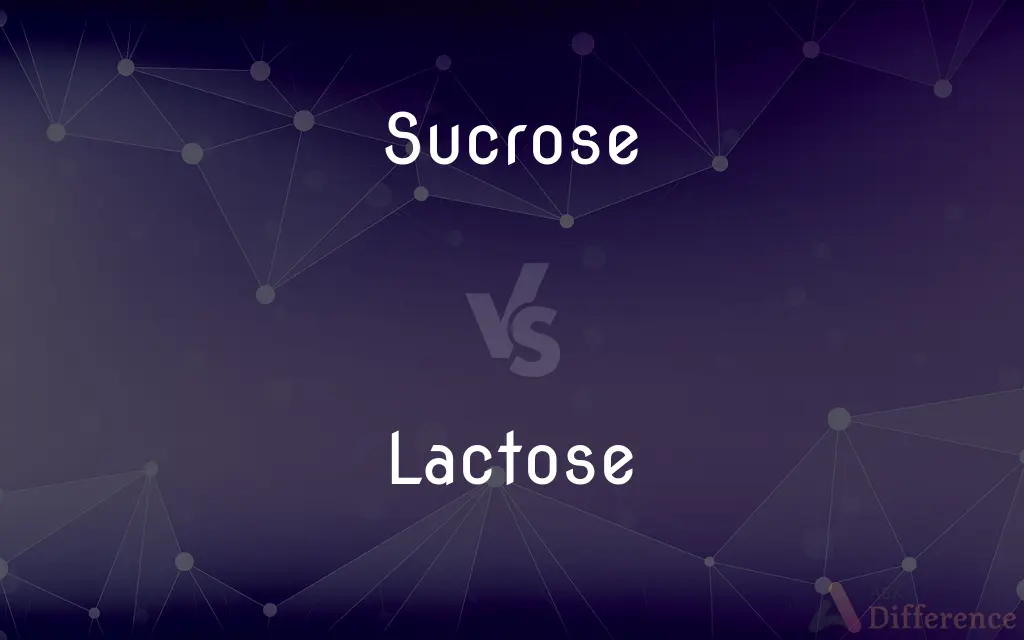Sucrose vs. Lactose — What's the Difference?
By Maham Liaqat & Urooj Arif — Updated on April 15, 2024
Sucrose, commonly table sugar, is a disaccharide of glucose and fructose; lactose, or milk sugar, is a disaccharide composed of glucose and galactose.

Difference Between Sucrose and Lactose
Table of Contents
ADVERTISEMENT
Key Differences
Sucrose is a disaccharide derived from glucose and fructose, commonly found in plants, especially sugarcane and sugar beets. Whereas lactose, another disaccharide, combines glucose and galactose, and is primarily found in milk and dairy products.
Sucrose is extensively used as a sweetener in various food products and beverages due to its high sweetness. On the other hand, lactose is less sweet and often contributes to the texture and flavor of dairy products rather than acting primarily as a sweetener.
Sucrose is digested by the enzyme sucrase, which splits it into its constituent sugars, glucose and fructose. Whereas lactose is broken down by lactase into glucose and galactose, a process that some adults find difficult due to lactase deficiency, leading to lactose intolerance.
Sucrose does not contribute to lactose intolerance and can be consumed by individuals with this condition. In contrast, lactose consumption by lactose-intolerant individuals can result in digestive discomfort, such as bloating, gas, and diarrhea.
While sucrose is often associated with increased risks of dental caries and metabolic disorders when consumed in large quantities, lactose, due to its lower sweetness and different metabolic pathway, is generally considered less likely to contribute to these conditions.
ADVERTISEMENT
Comparison Chart
Composition
Glucose + Fructose
Glucose + Galactose
Common Source
Sugarcane, sugar beets
Milk, dairy products
Sweetness
High
Low
Digestive Enzyme
Sucrase
Lactase
Associated Conditions
Dental caries, metabolic issues
Lactose intolerance
Compare with Definitions
Sucrose
A disaccharide composed of glucose and fructose, extracted from sugarcane or sugar beets.
Sucrose is often refined to produce white sugar.
Lactose
A natural sugar found in milk and dairy products, comprising glucose and galactose.
Lactose gives milk its slightly sweet taste.
Sucrose
The scientific term for table sugar, widely used in baking and sweetening beverages.
Sucrose gives the cake its sweet taste.
Lactose
Digested by the enzyme lactase, which many adults lack in sufficient quantity.
People with lactose intolerance cannot properly digest lactose.
Sucrose
Broken down by the enzyme sucrase in the human digestive system.
The sucrase enzyme helps in digesting sucrose.
Lactose
The main carbohydrate in milk, essential for the dietary needs of infants.
Lactose is crucial for energy in young mammals.
Sucrose
A carbohydrate that provides quick energy but lacks nutritional value.
Sports drinks often contain high levels of sucrose.
Lactose
Less sweet compared to sucrose and used in pharmaceuticals as a filler.
Lactose is commonly used in the preparation of pills.
Sucrose
Known to contribute to obesity and diabetes when consumed excessively.
Excessive sucrose intake can lead to health issues.
Lactose
Can cause digestive problems for individuals with lactose intolerance.
Drinking milk may cause discomfort for those sensitive to lactose.
Sucrose
Sucrose is made up of one molecule of glucose and one molecule of fructose joined together. It is a disaccharide, a molecule composed of two monosaccharides: glucose and fructose.
Lactose
Lactose is a disaccharide. It is a sugar composed of galactose and glucose subunits and has the molecular formula C12H22O11.
Sucrose
A crystalline disaccharide of fructose and glucose, C12H22O11, extracted chiefly from sugarcane and sugar beets and commonly known as table sugar. Also called saccharose.
Lactose
A white crystalline disaccharide, C12H22O11, found in milk, that may be hydrolyzed to yield glucose and galactose. Refined lactose obtained from whey is used in infant foods, bakery products, confections, and pharmaceuticals as a diluent and excipient. Also called milk sugar.
Sucrose
(carbohydrate) A disaccharide with formula C12H22O11, consisting of two simple sugars, glucose and fructose; normal culinary sugar.
Lactose
(carbohydrate) The disaccharide sugar of milk and dairy products, C12H22O11, a product of glucose and galactose used as a food and in medicinal compounds.
Sucrose
A common variety of sugar found in the juices of many plants, as the sugar cane, sorghum, sugar maple, beet root, etc. It is extracted as a sweet, white crystalline substance which is valuable as a food product, and, being antiputrescent, is largely used in the preservation of fruit. Called also saccharose, cane sugar, etc. At one time the term was used by extension, for any one of the class of isomeric substances (as lactose, maltose, etc.) of which sucrose proper is the type; however this usage is now archaic.
Lactose
The main sugar present in milk, called also sugar of milk or milk sugar. When isolated pure it is obtained crystalline; it is separable from the whey by evaporation and crystallization. It is a disaccharide with the formula C12H22O11, being chemically 4-(
Sucrose
A complex carbohydrate found in many plants and used as a sweetening agent
Lactose
See Galactose.
Lactose
A sugar comprising one glucose molecule linked to a galactose molecule; occurs only in milk;
Cow's milk contains about 4.7% lactose
Common Curiosities
Can people with lactose intolerance consume sucrose?
Yes, people with lactose intolerance can consume sucrose as it does not contain lactose.
Where is lactose found?
Lactose is primarily found in milk and dairy products.
Why is sucrose considered sweeter than lactose?
Sucrose has a higher sweetness level compared to lactose.
Can lactose be harmful?
For individuals with lactose intolerance, consuming lactose can lead to digestive discomfort.
Is sucrose vegan?
Sucrose is vegan as it is derived from plants.
What are the dietary sources of lactose?
Lactose is mainly obtained from milk and dairy products.
What is sucrose made of?
Sucrose is made of glucose and fructose.
Are there health risks associated with sucrose?
Yes, excessive consumption of sucrose can lead to obesity, diabetes, and dental issues.
What enzymes digest sucrose and lactose?
Sucrose is digested by sucrase, while lactose is digested by lactase.
How do sucrose and lactose differ in their absorption?
Sucrose is quickly broken down into glucose and fructose, whereas lactose is slower due to varying enzyme effectiveness.
How are sucrose and lactose similar?
Both are disaccharides and provide energy.
Is lactose ever added to non-food products?
Yes, lactose is used in the pharmaceutical industry as a filler in tablets.
What happens if someone lacks the enzyme to digest sucrose or lactose?
Lacking the enzyme sucrase leads to sucrose malabsorption, while lacking lactase leads to lactose intolerance.
Can lactose be found in non-dairy products?
Lactose is generally not found in non-dairy products unless added as an ingredient.
What are common uses of sucrose?
Sucrose is commonly used for sweetening, in baking, and in confectionery.
Share Your Discovery

Previous Comparison
Cartilage vs. Ligament
Next Comparison
Dispersion vs. DispersalAuthor Spotlight
Written by
Maham LiaqatCo-written by
Urooj ArifUrooj is a skilled content writer at Ask Difference, known for her exceptional ability to simplify complex topics into engaging and informative content. With a passion for research and a flair for clear, concise writing, she consistently delivers articles that resonate with our diverse audience.













































